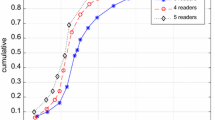Abstract
One of the biggest challenges in RFID (radio frequency identification) large scale deployment, such as in warehouse RFID deployment, is the positioning of RFID reader antennas to efficiently locate all the tagged objects distributed at RFID reader environment. This paper has investigated a novel location sensing system based on geometric grid covering algorithm that can use any passive or active RFID standard for positioning or tracking objects inside buildings. This study involves design of RFID reader antenna network which focuses on placing the reader antennas on a grid to cover all the tags distributed at two dimensional planes and position calculation using statistical averages algorithm. The statistical averages algorithm simply computes the location coordinates of the tagged object by statistical average of the reader antenna’s location. The proposed grid of reader antennas can assist in minimizing the actual number of reader antennas required for RFID large scale deployment. The proposed prototype system is a simpler positioning system which presents the solution of placement pattern of RFID reader antennas, gives less complicated mathematical calculation, and is able to provide a high degree of accuracy. The obtained results show that the proposed location sensing system can achieve better positioning accuracy as compared to existing positioning system and in some cases accuracy improvement of about 50% can be reached.
Similar content being viewed by others
References
Hightower, J., & Borriello, G. (2001). A survey and taxonomy of location sensing systems for ubiquitous computing. Technical Report CSE 01-08-03, University of Washington, Seattle, WA, August 2001.
Bahl, P., & Padmanabhan, V. N. (2000). RADAR: An in building RF-based user location and tracking system. In Proceedings of the IEEE Conference on Computer Communications (INFOCOM), Vol. 2, pp. 775–784, 2000.
Smailagic A. and Kogan D. (2002). Location sensing and privacy in a context—aware computing environment. IEEE Wireless Communication 9(5): 10–17
Finkenzeller, K. (2003). RFID handbook: Fundamentals and applications in contactless smart cards and identification. Chichester: John Wiley, Leipzig, dritte edition.
Hightower, J., Want, R., & Borriello, G. (2000). SpotON: An indoor 3D location sensing technology based on RF signal strength. In: Technical Report UW CSE 2000–02–02, University of Washington, February 2000.
Ni L.M., Liu Y., Lau Y.C. and Patil A.P. (2004). LANDMARC: Indoor location sensing using active RFID. Journal of Wireless Networks 10(6): 701–710
Ingamells, M., & Kober, J. (2005). Improving final test throughput via RFID tracking of probe cards. In Proceedings of the International Symposium on Semiconductor Manufacturing (ISSM), San Jose, California, pp. 80–83, September 2005.
Jones, P. (2006). Networked RFID for use in the food chain. In Proceedings of the IEEE International Conference on Emerging Technologies and Factory Automation (ETFA), Czech Republic, pp. 1119–1124, September 2006.
Gupta P. and Kumar P.R. (1998). Critical power for asymptotic connectivity in wireless networks. In: McEneany, W.M., Yin, G. and Zhang, Q. (eds) Stochastic analysis, control, optimization and applications: A volume in honor of W. H. Fleming, pp 547–566. Birkhauseo, Boston
Kershner R. (1939). The number of circles covering a set. American Journal of Mathematics 61: 665
Hall, P. (1988). Introduction to the theory of coverage processes. J Wiley.
Booth L., Bruck J., Franceschetti M. and Meester R. (2003). Covering algorithms, continuum percolation, and the geometry of wireless networks. Annals of Applied Probability 13(2): 722–741
Li, L. W., Lim, C. P., & Leong, M. S. (2001). Near field of electrically small thin square and rectangular loop antennas. Progress in Electromagnetics Research, PIER 31, pp. 181–193, 2001.
Patil, A., Munson, J., Wood, D., & Cole, A. (2005). BlueBot: Asset tracking via robotic location crawling. Tech Report RC23510, IBM T.J. Watson Research Center, Hawthorne, NY, February 2005.
Leong, K. S., Ng, M. L., Grasso, A. R., & Cole, P.H. (2006). Synchronization of RFID readers for dense RFID reader environment. In Proceedings of IEEE International Symposium on Applications and the Internet Workshops, Phoenix, Arizona, pp. 48–51, January 2006.
Wang, D., Wang, J., & Zhao, Y. (2006). A novel solution to the reader collision problem in RFID system. In Proceedings of IEEE International Conference on Wireless Communications, Networking and Mobile Computing (WICOM), Montreal, Canada, pp. 1–4, September 2006.
Zhou, S., Luo, Z., Wong, E., Tan, C. J., & Luo, J. (2007). Interconnected RFID Reader collision model and its application in reader anti-collision. In IEEE International Conference on RFID, Grapevine, Texas, USA, pp. 212–219, 2007.
Waldrop, J., Engels, D. W., & Sanna, S. E. (2003). Colorwave: A MAC for RFID reader networks. In IEEE Wireless Communications and Networking Conference (WCNC), New Orleans, Louisiana, USA, pp. 1701–1704, 2003.
Engels, D. W., & Sarma, S. E. (2002). The reader collision problem. In Proceedings of IEEE International Conference on Systems, Man and Cybernetics, Hammamet, Tunisia, Vol. 3, pp. 6, October 2002.
Iyengar, R., Kar, K., & Banerjee, S. (2005). Low-coordination topologies for redundancy in sensor networks. In Proceedings of the 6th ACM international symposium on Mobile ad hoc networking and computing, Urbana-Champaign, Illinois, USA, pp. 332–342, May 2005.
Author information
Authors and Affiliations
Corresponding author
Rights and permissions
About this article
Cite this article
Reza, A.W., Geok, T.K. Investigation of Indoor Location Sensing via RFID Reader Network Utilizing Grid Covering Algorithm. Wireless Pers Commun 49, 67–80 (2009). https://doi.org/10.1007/s11277-008-9556-4
Received:
Accepted:
Published:
Issue Date:
DOI: https://doi.org/10.1007/s11277-008-9556-4




